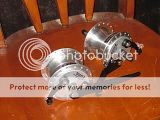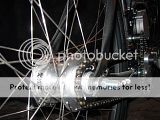If you have not noticed the trend in parts for Planes, Trains, Cars and Bicycles is to under engineer as much as possible. If you are popping spokes, bending axles and needing to bring out the spoke wrench allot then you probably need a stronger wheel at least on the rear of your motorized bicycle.
Some manufactures make the flanges on there hubs to thin. This thin flange can act like a knife on the spokes, especially if they are not properly tensioned. If a hub flange is below .050" it is to thin. A good example of this is my pops old wheel chair. The steel hubs were made of a very thin steel and they used 10 gauge spokes to compensate for the bad engineering. This works up to a point. When pop got over 250lbs this engineering technique failed. I am guessing the company who did this had issues like the cost of the product and the price of the machinery to make the product. I had the same problem on the original wheels that came on my tandem. The flanges were two thin and the spokes broke at the hub. I fixed both these problems by purchasing hubs with thicker flanges. The flanges on the replacement hubs are .100".
Spoke quality can be a problem also. A cheap spoke will have excessive stretch. Even if you properly tension the wheel when you build it, you will end up truing the wheel at an annoying rate and eventually have broken spokes. I use 14gage spokes made of SS. I use DT, Phil Wood, Wheel Smith and Union spokes. As we go with heavier spokes we also create a tendency for cracking the rim. If you build a wheel with double butted spokes the wheel can last longer. They do make 13/14ga double butted. The largest straight gauge that I would use is 13ga and I would be very careful on the overall spoke tension so the rim does not crack.
Rims can be purchased for racing touring and tandem use. I would say racing is out for MB purposes. Some companies weld their rims together and some glue and pin. Some rims that are designed for disk use will have a very rough or uneven spot at the joint and would be undesirable for use with rim brakes. I like rims with machined side walls for rim brake use.
The manufactures started using machines to build wheels a while back. The machinery is very expensive. They engineered around some problems and reduced cost on there end by deciding on using less spokes in mass production wheels. To compensate for this they first used a heavier rim. The difference between 36 and 32 spokes is enough to decrease the lateral strength of a wheel considerably. They told everybody that they had figured out how to make the wheel as strong with less spokes. They also spread the word that it was lighter. The old standard was 36 spokes. In England it was 40 on the rear and 36 on the front. I like 40 or 48 for a Tandem or heavy loaded touring bicycle. 36 for general use with riders not over 180 lbs. I consider 36 spokes on a quality wheel with properly engineered parts to be the minimum for The kind of use a person on a MB will give it.
Some manufactures make the flanges on there hubs to thin. This thin flange can act like a knife on the spokes, especially if they are not properly tensioned. If a hub flange is below .050" it is to thin. A good example of this is my pops old wheel chair. The steel hubs were made of a very thin steel and they used 10 gauge spokes to compensate for the bad engineering. This works up to a point. When pop got over 250lbs this engineering technique failed. I am guessing the company who did this had issues like the cost of the product and the price of the machinery to make the product. I had the same problem on the original wheels that came on my tandem. The flanges were two thin and the spokes broke at the hub. I fixed both these problems by purchasing hubs with thicker flanges. The flanges on the replacement hubs are .100".
Spoke quality can be a problem also. A cheap spoke will have excessive stretch. Even if you properly tension the wheel when you build it, you will end up truing the wheel at an annoying rate and eventually have broken spokes. I use 14gage spokes made of SS. I use DT, Phil Wood, Wheel Smith and Union spokes. As we go with heavier spokes we also create a tendency for cracking the rim. If you build a wheel with double butted spokes the wheel can last longer. They do make 13/14ga double butted. The largest straight gauge that I would use is 13ga and I would be very careful on the overall spoke tension so the rim does not crack.
Rims can be purchased for racing touring and tandem use. I would say racing is out for MB purposes. Some companies weld their rims together and some glue and pin. Some rims that are designed for disk use will have a very rough or uneven spot at the joint and would be undesirable for use with rim brakes. I like rims with machined side walls for rim brake use.
The manufactures started using machines to build wheels a while back. The machinery is very expensive. They engineered around some problems and reduced cost on there end by deciding on using less spokes in mass production wheels. To compensate for this they first used a heavier rim. The difference between 36 and 32 spokes is enough to decrease the lateral strength of a wheel considerably. They told everybody that they had figured out how to make the wheel as strong with less spokes. They also spread the word that it was lighter. The old standard was 36 spokes. In England it was 40 on the rear and 36 on the front. I like 40 or 48 for a Tandem or heavy loaded touring bicycle. 36 for general use with riders not over 180 lbs. I consider 36 spokes on a quality wheel with properly engineered parts to be the minimum for The kind of use a person on a MB will give it.









